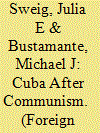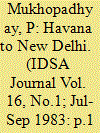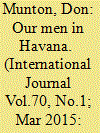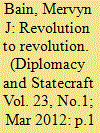| Srl | Item |
| 1 |
ID:
120805


|
|
|
|
|
| Publication |
2013.
|
| Summary/Abstract |
Cuba has entered a new era of economic reform that defies easy comparison to post-Communist transitions elsewhere. Washington should take the initiative and establish a new diplomatic and economic modus vivendi with Havana.
|
|
|
|
|
|
|
|
|
|
|
|
|
|
|
|
| 2 |
ID:
185283


|
|
|
| 3 |
ID:
111256


|
|
|
|
|
| Publication |
2011.
|
| Summary/Abstract |
At the turn of the twenty-first century, when Fidel Castro remained one of the world's few traditional communist leaders and his relations with the Catholic Church were frosty, the archbishop of the Orthodox Church of North and South America was invited to inaugurate a new church in Havana. This essay traces the origins of this event and places it in the context of communist Cuba's history and its relations with religious institutions.
|
|
|
|
|
|
|
|
|
|
|
|
|
|
|
|
| 4 |
ID:
151317


|
|
|
|
|
| Summary/Abstract |
Asymmetric relationships have been fundamental to the study of international relations, becoming even more important with the end of the Cold War, which left the United States as the sole global superpower. However, what impact does the distance between two countries have on the magnitude of an asymmetric relationship and the exposure of the countries to one another? This article examines these phenomena by analysing the relationship between Havana and Moscow from the time of the Russian Revolution in November 1917 to the present. Specifically it examines three distinct periods: from November 1917 until February 1960, from February 1960 until the implosion of the Soviet Union in late 1991 and from 1992 to the present. This article posits that the distance between two countries reduces neither the intensity of an asymmetric relationship nor the exposure of the two countries to one another.
|
|
|
|
|
|
|
|
|
|
|
|
|
|
|
|
| 5 |
ID:
137139


|
|
|
|
|
| Summary/Abstract |
Diplomats based at the Canadian embassy in Havana conducted extensive foreign intelligence operations in Fidel Castro’s Cuba from the early 1960s through the early 1970s. They collected human intelligence of both a political and military nature, using covert as well as overt means. They did so generally at the behest of the United States, and undertook specific “tasked” operations on request from the State Department and the US intelligence community. The diplomat-spies also collaborated operationally with United Kingdom personnel. This article represents the first detailed survey of the Cuba operations and attempts to place Canada’s foreign intelligence program in the context of its relations with the United States and of Canadian foreign policy generally.
|
|
|
|
|
|
|
|
|
|
|
|
|
|
|
|
| 6 |
ID:
111564


|
|
|
|
|
| Publication |
2012.
|
| Summary/Abstract |
It has traditionally been assumed that the relationship between Moscow and Havana commenced with the victory of the Cuban Revolution. Although it subsequently developed to unprecedented levels, this article examines the relationship in the period between the Russian and Cuban Revolutions. This analysis is conducted within the framework of Soviet policy towards the Developing World and the realist paradigm of International Relations theory. Prior to January 1959, the Kremlin took a considerable interest in Cuba and did not suffer from "geographical fatalism" as has previously been presumed. This is important in itself, but also for the relationship that rapidly developed in the aftermath of the Cuban Revolution as a number of factors that were important in the pre-1959 relationship would also be significant after 1959. Furthermore, this analysis is also important for the contemporary bilateral relationship as both governments have made increasing reference to the multifaceted relationship that existed priorx to 1959.
|
|
|
|
|
|
|
|
|
|
|
|
|
|
|
|
| 7 |
ID:
138310


|
|
|
|
|
| Summary/Abstract |
This article examines the burst of airline hijacking that occurred from the U.S. to Cuba between 1968 and 1973. Attracted by Cuba s revolutionary mystique and seeking political asylum, sanctuary from racism, participation in Third World liberation movements, haven from criminal charges, and apolitical adventure, Americans hijacked more planes to Cuba during this period than all other global hijacking incidents combined. Constructing Cuba as an idealized imagined nation as an alternative to capitalism, white domination, and U.S. global hegemony and as a portal to Third World movements within the geopolitical context of the Cold War and decolonization, hijackers formulated themselves as beleaguered idealists and political refugees. Influencing U.S.-Cuba relations and resulting in an unprecedented diplomatic collaboration between the two nations to produce a mutual anti-hijacking agreement, the hijacking epidemic of 1968- 73 marks the unlikely meeting point where political protest movements, the African American freedom struggle, and U.S.-Cuba relations collided in the late 1960s.
|
|
|
|
|
|
|
|
|
|
|
|
|
|
|
|